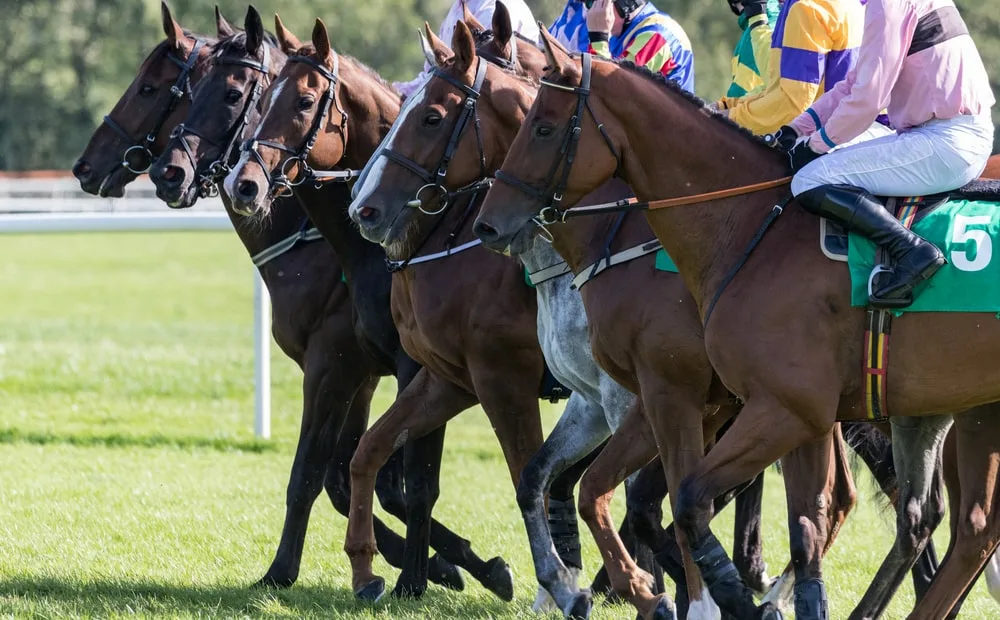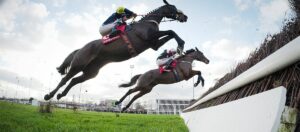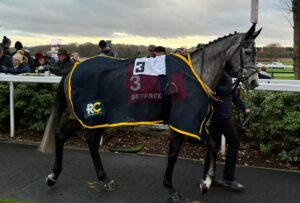Racing horse breeding is a centuries-old practice dedicated to breeding the fastest and strongest horses to compete in the big leagues. After so long, racing horses have been refined into some standout types that avid racing enthusiasts look for when supporting or buying them.
To help you get involved in the intricacies of racing horses and their features, we’ve compiled some of the best-known types and detailed them for you.
Ready to become a Horse Owner?
You’re just a few clicks away from starting this exciting adventure with RC Syndicates!
Buy a Share
What Are The Different Types Of Racehorses?
There are many breeds of racehorses which are suited to different kinds of races. Some are built for speed, some for jumping and others for appearance. Here’s a rundown of some of the most common and best-known types of racehorses.
Thoroughbred
Thoroughbred horses are, without a doubt, the most common horse you’ll find at the racetrack. Their origins date back to 17th and 18th century England when Arabian horses were brought back to Britain from the east for breeding. These eastern stallions were bred with native mares to create strong, fast and highly intelligent steeds.
These horses are well known for their athleticism and spirited natures, making them fantastic racehorses, although unsuitable for beginner equestrians. Their natural strength and high intellect make them responsive to training and well-suited to racing, jumping, dressage and polo.
Thoroughbred horses are usually one solid coat colour with little to no markings. While they come in many colours, they are most commonly seen in bay, black, brown, chestnut or grey. These are large horses; they range in size from around 15 to 17 hands (5–5’8 feet) and can reach speeds of 40mph.
Arabian
The origin of the Arabian horse goes back further than recorded history, with some of its earliest mentions traced back to 3000 BCE. They’ve been popular breeding horses worldwide, contributing their intelligence, speed and graceful nature to many other racing horse breeds, including Thoroughbred and Standardbred.
Arabian horses are well known for their versatility in horse occupations. Their strong and compact build makes them ideal workhorses, their intelligence and speed are great for racing, and their elegance is perfect for dressage and shows. In the hands of the right trainer, an Arabian horse could be used in any field.
Arabian horses err on the smaller side, standing between 14 and 16 hands (4’8–5’4 feet). Possible purebred colours are grey, chestnut, black, bay and roan, and while they usually have solid colour coats, they can have white markings, such as socks or stockings. Distinctive features include their long arched necks, concave heads and large eyes.
Standardbred
Famously, Standardbred horses date back to a Thoroughbred horse brought to America from Britain in 1788 called Messenger. This horse’s grandsire, Hambletonian, would become the main root from which all Standardbred horses are bred. Standardbred horses are similar to Thoroughbreds but are usually smaller and more compact.
Standardbred horses were bred for harnessed races, so they’re hardy, strong and excel in trotting speed. They’re also calm, friendly horses that make loyal companions that respond well to training. While their build makes Standardbred horses suitable for jumping and endurance riding, their good temperament also makes them ideal for pleasure riding.
The most common colours of Standardbred horses are bay, black and brown. Their average height is between 15 and 16 hands (5–5’3 feet), and they tend to be more muscular and lower set than their Thoroughbred cousins.
American Quarter Horse
Considering its name, it’s unsurprising that the American Quarter Horse is the horse of choice in the USA. This breed came about around the 1600s, bred from imported Spanish and British horses; they were optimised to ride in quarter-mile races, hence the name. Their speeds over short distances are some of the best, reaching 55mph; however, they aren’t so well suited to endurance events.
The American Quarter Horse has excellent speed and strength and is eager to please, making it a fantastic workhorse. It found its calling for centuries as the primary American workhorse, famously used by cowboys on the frontier for herding cattle. Nowadays, its highly versatile nature means it’s used for work, in events and as a popular family pet.
The Quarter Horse is small, averaging 14–16 hands (4’8–5’4 feet), and they tend to be quite stocky and muscular. They come in most solid colours, along with roan, buckskin and dun.
Appaloosa
The Appaloosa is a very famous horse known for its iconic speckled colouring. They were initially bred by north-western indigenous American populations, like the Nez Perce tribe, and didn’t find a wider popularity until the early 20th century after nearly being wiped out.
Throughout history, the Appaloosa has been used for work, transport and even as a war horse. Nowadays, they’re also popular breeds at rodeo and racing events. Appaloosa horses are ideal for endurance races, with their high stamina and strength, but they tend to be more popular in technical events such as cutting, barrel racing and pole bending.
These eye-catching horses are popular because of their beautiful coats and gentle and friendly natures, making them ideal for training and as companions. They’re even a popular breed for training children in horse riding. We also frequently see these horses in movies and television, as their distinctive appearances are well suited to film.
Appaloosas stand at an average of 14–16 hands (4’8–5’4 feet) and come in various colours and patterns, with additional markings. The Appaloosa horse registry has some recognised coat patterns, including leopard, blanket, snowflake and marble.
How to choose the best type of racehorse
Racehorse breeds are developed to excel in different fields and for different events. Consider the horse’s specialisation when picking which racehorse you want to own or back.
- Which races or events will it be participating in? You might be drawn to the thoroughbred for flat races, which excels in speed and endurance. But for shorter races, the American Quarter Horse could be the one for you.
- Different types of racehorses will be priced differently, especially if you take their bloodline into account. Thoroughbred horses from notable bloodlines could be priced into hundreds of thousands of pounds. More information about choosing the right racehorse can be found here.
- This will even affect the price of shares if you enter into a horse racing syndicate. You can find out more about these shares here.
Choose a reputable and reliable syndicator
If you want to buy a share in a racehorse, seek a reputable syndicator. A good syndicator will be open about the pros and cons of their horses, showing you their bloodline and letting you know about their behavioural patterns. Feel free to ask plenty of questions to understand better the syndicator you’ll be working with and whether they’re the right one for you.
Ready to become a Horse Owner?
You’re just a few clicks away from starting this exciting adventure with RC Syndicates!
Buy a Share




